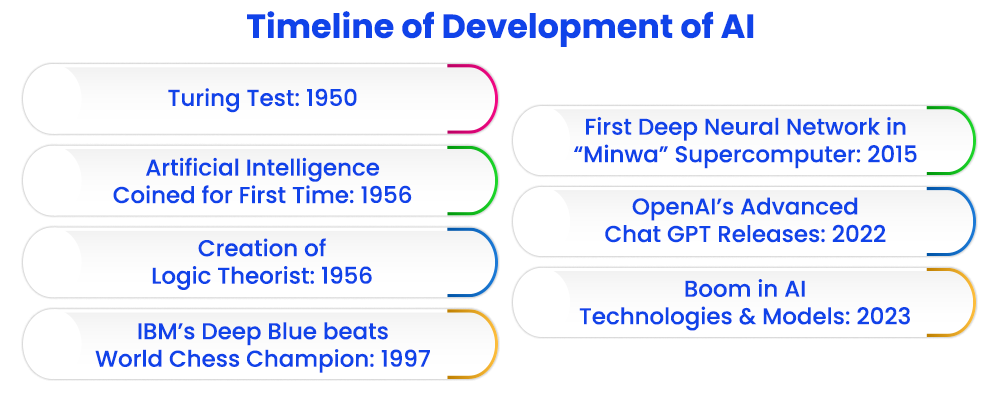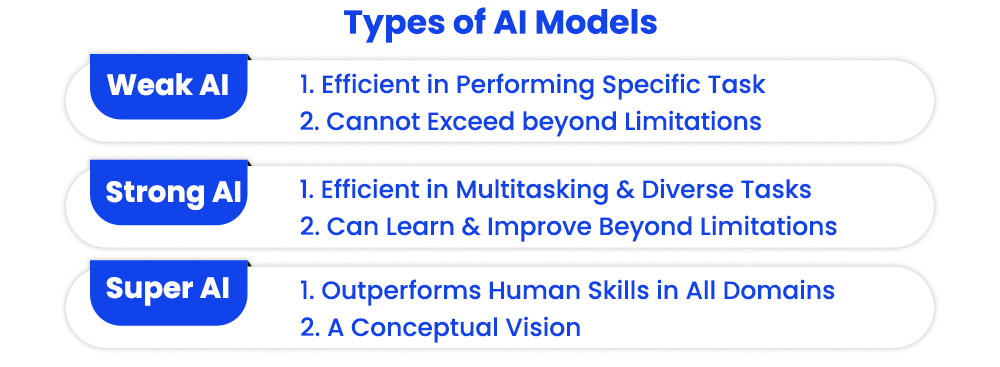Expert Interviews
- University Reviews
- Career Guide
 Video Counseling
Video CounselingImportant Facts
- Ask any Question - CV Forum

What is Artificial Intelligence (AI)? How Does It Work? [Starter Guide 2025]
College Vidya Team Jan 15, 2025 1.5K Reads

A recently booming subject domain in the field of computer science and technology is artificial intelligence–a term which has taken the tech-world and the 21st century by storm. The workings of artificial intelligence and the prospects of it competing with humans for performance is quite a fascinating domain drawing many technology enthusiasts and students to the field.
In this blog, we have prepared an introduction about the world of artificial intelligence for a beginner to explore and delved into the various aspects of AI–ranging from how it works, its applications to the types of AI models currently prevailing. So fasten your seatbelts to take a dive into the concepts of artificial intelligence and know the field further.
What is Artificial Intelligence?
As the name of the technology gives away, “artificial intelligence” reflects behaviours and reasoning resembling intelligent and efficient patterns in artificial mediums like machines, softwares and computers. At the heart of artificial intelligence is an endeavour to create systems and models that can simulate intelligence as exhibited by humans.
While machines and computers created uptil the recent past were highly efficient in carrying out tasks and calculations, artificial intelligence reflects a step further in the same mission, by training models and softwares to not only automate functions but operate on them in an intelligent fashion akin to that exhibited by humans. You May Interested | Executive Course In AI and Machine Learning!
The conceptualisation of artificial intelligence or AI as it is famously known as been diverse, with certain scientists focusing on the aspect of creating machines that “think and act like humans” (exemplifying a Human Approach) while others have concerned themselves with creating machines that “think and act rationally” (reflecting an Ideal Approach).
Artificial Intelligence (AI) has been defined by John Mccarthy (2004) as “the science and engineering of making intelligent machines, especially intelligent computer programs. It is related to the similar task of using computers to understand human intelligence, but AI does not have to confine itself to methods that are biologically observable.”
Commonly, AI models comprise the main functions of perception, reasoning, problem-solving and decision-making, learning and training.
Brief Timeline of History of Artificial Intelligence (AI)
While the popularity and widespread usage of artificially intelligent technologies has gained traction in the recent past, the development of AI can be traced back to nearly a century ago, with the inception of automation and strides being made in machine-led advancements. Also Available | AI and Machine Learning Certification!
Herein is a brief summary of the history of artificial intelligence through the early 1950s to the current developments taking place in the field.
- Turing Test (1950): The very first conceptualisations of AI technology as a capability of machines can be traced back to the development of the “Turing Test” by Alan Turing. The concept proposed of the test was to let a user determine whether the answer provided to a question/enquiry made by them was given by a person or a machine, thus planting the grassroot seeds of AI as a technology that can mimic human actions.
- Coining of the term “Artificial Intelligence” (1956): John McCarthy was the first expert to coin the term “artificial intelligence” in 1956 in an international conference at Dartmouth College.
- Creation of Logic Theorist (1956): In the same year wherein AI as a term was coined, the first-ever AI program was created and run by Shaw, Newell and Simon, called the “Logic Theorist”.
- Mark 1 Perceptron (1967): Rosenblatt guided the creation of “Mark 1 Perceptron”, which was one of the first machine softwares to exhibit trial and error learning, thus marking the inception of the foundations of machine learning principles.
- IBM’s Deep Blue (1997): The Deep Blue model developed by IBM marked one of the first instances wherein a machine outperformed a human in an intellectual and reasoning activity–it defeated the World Chess Champion Garry Kasparov in a chess match (history was later repeated when Ken Jennings and Brad Rutter were defeated in the game Jeopardy by IBM’s Watson in 2011!)
- First Deep Neural Network in a Computer (2015): The supercomputer ‘Minwa’ by Baidu was the first instance of a convolutional neural network (a type of deep neural network) in a machine, which rendered it capable of efficiently identifying images faster than a person.
- OpenAI’s Advanced Chat GPT Releases (2022): While developments in AI technology occurred throughout the 1980s to 2000s, the boom of modern AI technologies can be traced to the release of the AI chatbot called Chat GPT by OpenAI in December 2022. This unique and advanced AI model which could seamlessly simulate human conversation sparked the renewed interests in developing various applications utilising AI for a multitude of other arenas.
- Boom in AI Technologies and Models (2023): As traced earlier, from early 2023, the development of a large number of advanced and general AI models and tools has gained traction and resulted in the integration of these features in a variety of creative, art, designing, computational, technological and surveillance tools.

While there have been significant milestones in the development of progress in the field of artificial intelligence since the 1950s, it is still progressing and developing further, especially in India, where the digitalisation of services and functions is gaining pace slowly. Also Read | Data Science Vs Artificial Intelligence Vs Machine Learning!
Types of Artificial Intelligence: Evolution of AI Models
Ever since the inception of artificial intelligence as a conceptual domain followed by its application and development, there have been two schools of thought regarding the objective sought by AI as a feature. These paradigms include:
- Human Approach: This paradigm is focused upon the creation of AI technologies that are designed with the human intelligence and mental structure at the centre. Consequently, the standard that this approach seeks to achieve is the creation of machine programs and softwares which can mimic and simulate how the human mind works. The works of Turing reflect this approach.
- Ideal Approach: This paradigm moves beyond the “like a human” approach of conventional AI and seeks to achieve AI models and softwares designed to emulate nearly perfect rational performance and functions, i.e. performing and behaving not like humans, but beyond that in a further rational manner.
Based upon these approaches in AI, there are currently three types of artificial intelligence based on the multitude of tasks that they are designed to perform. Also Available | Diploma In AI and Machine Learning Online!
- Weak or Narrow AI: Weak AI or Narrow AI comprises applications and AI softwares that are well-trained to carry out specific functions or niche operations, but cannot perform functions beyond the trained domain. This model of AI is designed with certain inherent limitations and does not have the capacity of learning through trials and improving. For example, the virtual assistants in electronic gadgets and devices are weak AI models which are trained to specifically capture audio instructions, analyse them and provide outputs but cannot perform any other type of function, for which they have not been pre fed with data.
- Strong or General AI: The strong AI models are more advanced AI models that are designed to perform a wide variety of tasks and functions and can effectively learn and improve their functioning over time beyond their initial training data. Since they can perform a large number of tasks and operations, they are known as general AI models. A recent and popular example of general AI is the artificially intelligent chatbots like Google Bard and Chat GPT.
- Super AI: Super AI is the envisioned future of AI models that are expected to be advanced and complex enough to outperform humans in every function they can perform. They are also expected to be well-equipped in learning and development and contribute to breakthrough advancements in various fields of science, technology and human welfare. The Google Gemini AI model reflects this vision wherein the model has been trained in enhanced understanding and outperforming humans in a variety of skills.
Based on these 3 levels at which AI models, different models and softwares of AI have been proposed.

Models of AI Commonly Employed
As we have already discussed, AI can be of three major types, namely weak AI, strong AI or super AI. Based upon the consequent level at which an AI model is designed to function, they can belong to the following modes:
- Reactive Machines
As the name suggests, reactive machines are based on weak AI models and programmed to perform operations based solely on the received inputs from the user. They are developed to be efficient in a specific task or operation, and do not have ingrained machine learning technologies to store the knowledge of past actions and results or actively learn from them to enhance performance. These AI models do not have a memory of their own or the decision-making ability to capture past results and analyse them to guide future operations. Examples of this include simplistic camera or designing tools equipped to utilise AI features to provide better services.
- Limited Memory AI
Limited memory AI models are those created on the basis of strong AI and can smartly perform a number of functions by integrating presently available data and past actions. These models, however, are not designed to sufficiently alter their existing training datasets to come up with new ideas, in that they have a limited memory which is pre-fed and trained into the system of the model, and would require retraining in case any alterations in the model are required. A prime example of this type of model is the self-driving cars and the chatbots which are programmed to provide information up until a specific point of time.
- Theory of Mind based Models
Reflective of the vision of super AI, the theory of mind models of AI are a vision for the future of AI. They focus on the creation of AI models that, like humans, can understand the social, visual, emotional and situational cues to understand and analyse behaviours. While significant strides are being accomplished in research surrounding such models of AI, the currently developed models are not of this mode.
- Generative AI
Generative AI tools are models that are designed to provide outputs in a variety of formats by analysing raw data to provide statistically probable results, which resemble the original data closely but are not identical to it in the same form. For instance, common generative AI models include chatbots like Chat GPT, that can analyse the original data fed to them in their dataset and analyse them to provide non plagiarised responses based on the original information. Other forms of generative AI include art creation applications that can effectively use raw informational data to generate new art pieces.
- Self-Awareness Based Models
Self-awareness based models of AI are reflective of super AI and encompass a concept of artificially intelligent machines that would be able to completely replicate human thinking and behaviour including their abilities of thinking, metacognition, consciousness, emotionality and creativity. Such models are not only visualised as being socially intelligent as humans but are expected to outperform them in all aspects including having advanced capabilities that humans lack.
Thus, in so far, we have explored the various types and models of AI tools that are currently being developed and empirically explored by technological experts and scientists.
|
|
|
|
|
|
|
|
|
How Does Artificial Intelligence Work?
Although an overview of AI and its types brings to light certain key aspects related to its functioning, the nuances of the actual working of these models are quite complex, multilayered and sophisticated. Central to the effective functioning of any AI model are aspects such as machine learning, deep learning and natural language processing.
Given below is a brief overview about how these aspects influence the development and working of AI models.
- Role of Machine Learning
Machine learning (ML) is a domain of artificial intelligence that emphasises the use of statistical analysis, predictive analysis and detailed algorithms to enable the AI model to learn from past operations and the training datasets. It is one of the key components of artificial intelligence technologies that make them adaptive and advanced and contribute to their continuous updating.
- Role of Deep Learning (briefly mention input, hidden and output layer)
Deep learning is a subset of machine learning, and is a quality of AI models that enable them to truly mimic the patterns of human neural networks. Deep learning is involved with the creation of systematic neural networks in the AI model that is capable of identifying existing patterns of data, noise as well as confusion sources in existing data. The functioning of deep learning operates at three levels, starting off with the input layer, moving forward at the hidden layer where processing and analysis occur followed by the output layer.
- Overview of Natural Language Processing (NLP)
Natural language processing is one of the special components of AI functioning which is required in the case of chatbots and virtual assistants. NLP technologies enable an AI computer software to simulate human conversational styles on the basis of vast training datasets fed to them about various types of verbal inputs, questions, enquiries, their plausible replies and so on. This technology leverages the generative AI and strong AI models to run algorithms and statistical analysis to produce a verbal output as closely similar to human conversation as possible, yet unique and non-plagiarised.

While machine learning, deep learning and NLP constitute the core of most AI models, the actual functioning of such models is highly complex, requiring complex statistical analysis, predictive analysis, coding and development, training through detailed datasets and regular programming to ensure the model is updated with the latest required information and features.
Arenas of Applications of Artificial Intelligence (AI) Technologies
Until now, we have explored the various aspects of artificial intelligence (AI) technologies including the types of AI that can be deployed in various gadgets and applications. Herein, we have highlighted a few of the prominent areas where AI principles have found usage and are being utilised for various uses.
- Voice Recognition
Voice recognition is one of the main areas in which AI features are being utilised to provide accurate outputs. AI technologies greatly contribute to the accurate perception and interpretation of audio input to understand the instruction/enquiry and further carry out the operation based on the instruction. Some of the domains in which the voice recognition services of AI are put to use include chatbots and search engines which can receive inputs in audio format to provide search results and chats, transcription applications which can convert dictated audio input to transcribe it to text as well as in biometric surveillance for identifying the voice of specific users by matching the voice qualities to specific stored data in the model’s datasets.
- Chatbots and Conversational AI
Chatbots and conversational AI includes models and softwares that are designed to provide a virtual chatting interface to users wherein an AI bot interacts and answers the queries and inputs of the user in a manner resembling human conversational patterns. AI-powered chatbots have become highly popular since the release of OpenAI’s model, Chat GPT, with free access. AI-powered chatbots are enabled with features that help them perform a variety of functions and operations such as mathematical and logical problem-solving, interpretation and analysis, conversation, paraphrasing and summarising tasks etc., thus making them useful in a variety of domains.
- Mathematical and Reasoning-Based Applications
Another major arena where AI-powered technology has proven massively instrumental in supporting human intelligence is through its advanced mathematical and logical reasoning skills. AI models are trained and honed in performing statistical analysis, programmed to carry out complex mathematical operations and logical problem-solving and provide accurate results to users in a short span of time. The problem-solving skills of AI models have been put to use in various mathematical applications, chatbots and the like for providing educational assistance to students as well as professionals.
- Creative Art and Music AI Tools
Generative AI models have found widespread usage in recent times in a number of creative arenas such as fine arts, graphic designing, musical pieces, writing and so on. Creative AI and musical AI tools take inputs from the users, usually in the form of textual descriptions, and utilise the inputs to create unique animated art pieces or musical pieces. Such applications have become highly useful for graphic designers and studio editors for coming up with unique ideas and outputs, an instance of the combination of human intelligence and the prowess of AI.
- Virtual Assistants
Virtual assistants and narrow AI tools that are designed to receive inputs from users (usually in the form of audio inputs) and carry out a number of digital functions on the basis of these inputs. Virtual assistants are integrated with electronic gadgets and platforms to provide round the clock services to users and ease virtual navigation to provide enhanced user experiences.
In addition to the aforementioned applications of AI, the domains in which it is being put to use are diversifying recently. Some other pertinent areas of application of AI include:
- Predictive purposes such as stock price prediction, weather prediction etc.
- Facial recognition and detection for surveillance
- Recommendation systems including music recommendation, personalised FYP pages on social media etc.
- Scheduling and planning such as in the case of doctors’ appointment scheduling
- Real-time translatory and notes-taking purposes etc.
Conclusion
Thus, it can be seen that artificial intelligence is a domain of technology with an expansive scope which is only expected to exponentially grow in the near future. The scope of AI applications are massive and consequently, the career opportunities in the field are also turning diverse and prosperous with time. Thus, if a technology enthusiast is fascinated by the field and desirous of developing a career in AI, then the field is ripe with novel opportunities to explore and contribute to for further breakthroughs.
Trending Articles
|
|
|
|
|
|
|
|
|
|
|
|
|
|
|
|
|
|
|
|
|
|
|
|
|
|
|
|
|
|
|
|
|
FAQs (Frequently Asked Questions)
Artificial intelligence is the domain of technology that seeks to develop models and softwares that possess intelligence similar to humans and are able to perform a variety of tasks and operations including analysis and interpretation, problem-solving, reasoning, decision-making etc.
Artificial intelligence technologies work through the integration of well-developed AI models that can read and analyse pre-fed datasets and draw insights based on statistical analysis. Their machine learning features allow them to learn with trials and errors, deep learning features allow them to develop neural networks akin to human memory and NLP features allow for the simulation of a human-like conversational pattern. However weak AI models may not include all such comprehensive features and work on the basis of specific programming without scope of improvement and learning.
The virtual assistants like Siri, Alexa, Google Assistant etc. are common examples of AI-integrated softwares that can smartly understand human instructions and enquiries and accordingly interpret them to perform specific functions and operations. Chatbots like Chat GPT are another common example of AI in use.
The proliferation of AI technologies in recent times have raised important concerns about whether the widespread usage of AI is beneficial or detrimental to the progress of humankind. While the benefits of AI and its vast utilities are well-established, it may have negative implications for the self-reliance of humans, their employability as well as their cybersafety and digital privacy. Explore the advantages and disadvantages associated with the use of AI further here.
Currently, there are three types of AI models being deployed, namely weak AI (enhanced functioning in a niche arena), strong AI (programmed to perform a vast variety of tasks efficiently) and super AI (envisioned to outperform humans in a large variety of functions). While weak and strong AI models are commonly being used in a number of domains, super AI is a research area being conceptualised as the future of AI.
The creation of conceptualisation of AI can be historically traced to the “Turing Test” developed by Alan Turing wherein a user was asked to predict whether the response given to a query made by them was given by a person or a machine.
There are a vast number of applications of AI among which a few of the prominent ones include AI-based chatbots such as Chat GPT, biometric and surveillance functions including facial recognition and detection, creative AI tools for art, music etc., and so on.

Idea Alchemist / Concept Creator / Insight Generator
We are an online education platform where users can compare 100+ online universities on 30+ X-factors in just 2 minutes. With an active CV community, we have transformed online learning to quite an extent. With the CV Subsidy scheme, we contributing to GER in India while helping our learners with their finances in their “Chuno Apna Sahi” journey!
Every query is essential.
Our team of experts, or experienced individuals, will answer it within 24 hours.
Recommended for you
Tired of dealing with call centers!
Get a professional advisor for Career!
LIFETIME FREE
Rs.1499(Exclusive offer for today)

Pooja
MBA 7 yrs exp

Sarthak
M.Com 4 yrs exp

Kapil Gupta
MCA 5 yrs exp
or



Career Finder
(Career Suitability Test)
Explore and Find out your Most Suitable Career Path. Get Started with our Career Finder Tool Now!
ROI Calculator
Find out the expected salary, costs, and ROI of your chosen online university with our free calculator.

